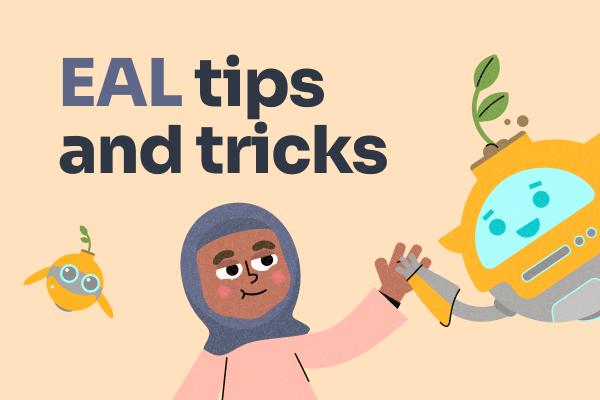

Are you looking for suggestions on how to improve your EAL provision? You might be looking to implement good assessment processes or searching for new EAL activities to spark your learners’ curiosity.
We’ve done the heavy lifting for you with this guide of helpful tips to fine-tune your EAL strategy.
1) Draw on your students’ home language
Why?
Home-language skills, just like problem-solving, creativity and literacy, transfer effectively to learning English as an Additional Language, supporting vocabulary and concept comprehension.
In increasingly multilingual classrooms, the need to support good integration through celebration and collaboration becomes crucial to supporting good long-term outcomes for EAL learners.
How?
- Celebrate students’ cultural and linguistic heritage, e.g., “Polish word of the week” or share cultural celebrations with classmates where new words and phrases can be learnt together.
- Offer dual-language books or audio materials; using them before English texts helps create associations between home language and English words.
- Bilingual dictionaries can help learners to highlight unfamiliar words in a text and make direct associations with their home language in the wider context of the text.
- Encourage language ambassadors – such as older students supporting younger peers. This is particularly helpful for new arrivals to support them in settling into a new environment.
- Conduct first-language assessments to distinguish EAL from potential SEN challenges.
- Group EAL activities, such as multilingual treasure hunts to encourage group learning and inclusion.
2) Use assessment and track progress
Why?
Baseline assessments help you tailor support for learners while regular follow-up checks help to measure progress and support transitions. This is key to having a good understanding of resource needs, as well as supporting student outcomes. If your EAL assessment structure is robust, this also simplifies the task of reporting to SLT, governors, parents and carers.
How?
- Use a simple, consistent four-skills assessment model (speaking, listening, reading, writing).
- Share learner profiles with colleagues for a whole school approach to scaffold your EAL students.
- Complete regular assessments to track progress and celebrate improvements. A minimum of once per term is best for new arrivals. Understanding your students’ proficiency helps to tailor support.
- Consider a digital assessment tool. EAL learning and assessment tools, like FlashAcademy®, streamline the process and save staff time, providing a comprehensive EAL solution that fits into wider EAL strategies.
3) Use engaging games and EAL activities
Why?
Research shows that when learners are relaxed and having fun, they are more willing to take risks with language, practise new words and join in with others.
Games create natural opportunities for repetition, which helps vocabulary stick, and they encourage real communication rather than just memorising rules. They also build confidence, as children can try things out in a low-pressure, playful environment. Importantly, games promote collaboration, helping EAL learners feel included and connected with their peers while developing both language and social skills.
How?
- Friendly competitions such as leaderboards and golden ticket rewards motivate learners and create camaraderie.
- Barrier games offer an opportunity for learners to collaborate and to work on both receptive and expressive communication skills, such as describing an object that their partner can’t see, or completing a timeline where each learner has different pieces of information to contribute.
- Embed collaborative, low-pressure roles in drama and role play work to build confidence over time. This is a great way to include learners who are new to English. An example activity is where each learner contributes an idea towards a scene that more confident learners can then act out.
- Set clear, manageable goals (e.g. “learn 5 new words this week”) and allow learners to track their own progress to keep motivation high.
- Use jigsaw games in language learning to encourage teamwork, critical thinking and participation. A picture story jigsaw, for example, where learners work in turn to sequence the story, uses skills in narrative language, connectors and sequencing.
- Any reward-based feedback should be immediate and visible, whether through verbal praise or visual display so learners can see growth and stay motivated.

4) Inclusion and psychological safety
Why?
EAL learners, especially new arrivals, may be coming from a wholly different context and harbouring insecurity about the possibility of making a misstep socially or culturally as well as with language learning. Risk-taking is essential in learning a new language and psychological safety creates an environment where mistakes are seen as part of the process and not as a failure. Learners who feel included by their peers are more confident and less stressed, freeing up the cognitive load for language learning.
How?
- Keep EAL learners integrated with peers most of the time to promote social and academic inclusion.
- Start lessons with social games and activities to build friendships and help new arrivals settle in.
- Normalise mistakes in learning, modelling this yourself as well as praising effort and risk-taking.
- Use texts, displays and resources that reflect diverse cultures, names and experiences, helping learners to see themselves represented.
- Design low-stakes speaking opportunities such as peer sharing or self-recorded tasks so EAL pupils practising vocabulary aren’t always in front of the full class.
- Use plain English and chunk instructions, supporting where possible with visuals.
5) Encourage independent learning
Why?
Independent learning enables learners to feel ownership of their progress, growing their confidence and sense of agency. It gives them more exposure and practice in a lower pressure environment, allowing them to move at their own pace.
During transitions and disruptions, confidence is often undermined and strengthening this in a safe environment supports language acquisition. Learner autonomy is also important for lifelong learning and preparation for adulthood, with self-directed learning habits playing a critical role in sustained EAL language development.
How?
- Give pupils choice over what words to study, which tasks to pursue, or how to present the information so they feel a sense of agency.
- Set clear, achievable goals for EAL activities such as “learn five new words this week” or “write three sentences in the past tense.”
- Celebrate even the small wins to encourage confidence.
- Scaffold more challenging independent tasks at first, then reduce teacher support over time so students become more self-reliant.
- Encourage independent learning via apps or digital assessment tools like FlashAcademy®. Offer reading materials matched to the students’ level or an English language learning and vocabulary journal.
6) Engage parents and carers
Why?
The involvement of parents and carers is foundational to academic success. Open and respectful communication also builds a sense of psychological safety for the learner and their parents or carers, increasing the learner’s sense of belonging. Where parents are not first language English speakers, the risk of social isolation is higher.
Involving parents and carers can provide the missing piece of the puzzle in supporting children and young people who might have additional learning needs, distinguishing between normal levels of English acquisition and SEN.
How?
- Encourage the family to continue speaking, reading and writing in their home language together too to boost language acquisition.
- Provide translators and interpreters for meetings and reports.
- Provide multilingual word lists or use apps, like FlashAcademy®, that the learner can continue with home support.
- Involve parents and carers in cultural events, assemblies or projects where they can use and celebrate their first language.
- Display multilingual signage for parents’ evenings.
- Build two-way communication through bilingual home-school journals.
- Set a holiday challenge to encourage a whole family approach to learning and encourage further independence. If you’re looking for a ready-made EAL activities for holidays, check out the FlashAcademy® EAL holiday challenge.
Supporting pupils who are learning English as an Additional Language is both a challenge and a privilege. Every strategy you try, whether it’s building vocabulary through games, celebrating a child’s first language, or creating safe opportunities for them to take risks, can make a profound difference to their confidence and progress.
Your EAL learners bring with them a diversity of knowledge, ideas and opportunities to the life of your school. By creating inclusive, whole-school approaches to EAL provision, you can help set them up for success both in the classroom and beyond.

